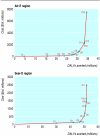Cost effectiveness analysis of strategies to combat HIV/AIDS in developing countries
- PMID: 16282380
- PMCID: PMC1315644
- DOI: 10.1136/bmj.38643.368692.68
Cost effectiveness analysis of strategies to combat HIV/AIDS in developing countries
Abstract
Objective: To assess the costs and health effects of a range of interventions for preventing the spread of HIV and for treating people with HIV/AIDS in the context of the millennium development goal for combating HIV/AIDS.
Design: Cost effectiveness analysis based on an epidemiological model.
Setting: Analyses undertaken for two regions classified using the WHO epidemiological grouping-Afr-E, countries in sub-Saharan Africa with very high adult and high child mortality, and Sear-D, countries in South East Asia with high adult and high child mortality.
Data sources: Biological and behavioural parameters from clinical and observational studies and population based surveys. Intervention effects and resource inputs based on published reports, expert opinion, and the WHO-CHOICE database.
Main outcome measures: Costs per disability adjusted life year (DALY) averted in 2000 international dollars (Int dollars).
Results: In both regions interventions focused on mass media, education and treatment of sexually transmitted infections for female sex workers, and treatment of sexually transmitted infections in the general population cost < Int150 dollars per DALY averted. Voluntary counselling and testing costs < Int350 dollars per DALY averted in both regions, while prevention of mother to child transmission costs < Int50 dollars per DALY averted in Afr-E but around Int850 dollars per DALY in Sear-D. School based education strategies and various antiretroviral treatment strategies cost between Int500 dollars and Int5000 dollars per DALY averted.
Conclusions: Reducing HIV transmission could be done most efficiently through mass media campaigns, interventions for sex workers and treatment of sexually transmitted infections where resources are most scarce. However, prevention of mother to child transmission, voluntary counselling and testing, and school based education would yield further health gains at higher budget levels and would be regarded as cost effective or highly cost effective based on standard international benchmarks. Antiretroviral therapy is at least as cost effective in improving population health as some of these interventions.
Figures
References
-
- UNAIDS, World Health Organization. AIDS epidemic update: December 2004. Geneva: UNAIDS, WHO, 2004.
-
- Gutierrez JP, Bertozzi S. Resource availability for HIV/AIDS and the funding gap. XV International AIDS Conference Satellite Session: resource tracking and priority setting, July 2004. Kaiser Family Foundation. www.kff.org/hivaids/upload/Resource-Availability-for-HIV-AIDS-the-Fundin... (accessed 28 Oct 2005).
-
- Schwartlander B, Stover J, Walker N, Bollinger L, Gutierrez JP, McGreevey W, et al. AIDS. Resource needs for HIV/AIDS. Science 2001;292: 2434-6. - PubMed
Publication types
MeSH terms
Grants and funding
LinkOut - more resources
Full Text Sources
Medical

